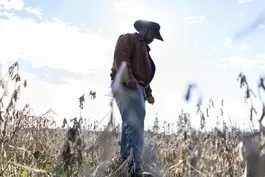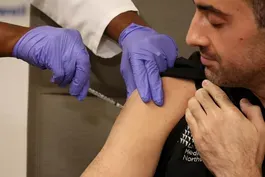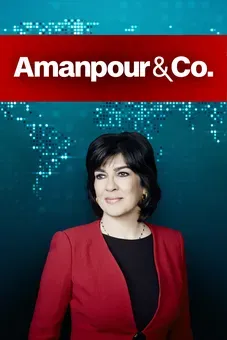
How extreme heat is contributing to a U.S. blood shortage
Clip: 8/24/2024 | 5m 11sVideo has Closed Captions
How extreme heat is contributing to a nationwide blood shortage
The American Red Cross says there’s an emergency shortage of blood for transfusions. In July, the national supply dropped by more than 25 percent. The Red Cross says the only solution is more blood donors. Jessa Merrill, director of biomedical communications at the Red Cross, joins John Yang to discuss.
Problems with Closed Captions? Closed Captioning Feedback
Problems with Closed Captions? Closed Captioning Feedback
Major corporate funding for the PBS News Hour is provided by BDO, BNSF, Consumer Cellular, American Cruise Lines, and Raymond James. Funding for the PBS NewsHour Weekend is provided by...

How extreme heat is contributing to a U.S. blood shortage
Clip: 8/24/2024 | 5m 11sVideo has Closed Captions
The American Red Cross says there’s an emergency shortage of blood for transfusions. In July, the national supply dropped by more than 25 percent. The Red Cross says the only solution is more blood donors. Jessa Merrill, director of biomedical communications at the Red Cross, joins John Yang to discuss.
Problems with Closed Captions? Closed Captioning Feedback
How to Watch PBS News Hour
PBS News Hour is available to stream on pbs.org and the free PBS App, available on iPhone, Apple TV, Android TV, Android smartphones, Amazon Fire TV, Amazon Fire Tablet, Roku, Samsung Smart TV, and Vizio.
Providing Support for PBS.org
Learn Moreabout PBS online sponsorshipJOHN YANG: The American Red Cross says there's an emergency shortage of blood for transfusions.
In July, the national supply dropped by more than 25 percent the Red Cross says the only solution is more blood donors.
Jessa Merrill is director of Biomedical Communications at the Red Cross.
Jessa, how did we get here?
What led to this?
JESSA MERRILL, Director of Biomedical Communications, American Red Cross: Sure, thanks so much for having me here.
There are a number of factors that have led us here.
For one the last few months have been extremely hot, so that heat alone, while hasn't just impacted, you know, our ability to enjoy the outdoors, it's actually impacted about 100 blood drives in July alone for the Red Cross.
And what I mean by impacted, it means that those blood drives either started late or ended early because the facility in which we were hosting, so that could be your local community organization, church, you name it, that those rooms were too hot.
A blood drive needs to be cool for people to have a good experience.
Think of like the grocery store, right?
When you walk in, it's sort of a naturally cool environment.
But in addition to that, we've seen really severe weather already in the month of August, right?
We've seen remnants from a hurricane Debbie fled most of the East Coast.
We've seen tornadoes throughout the Midwest, and then we've seen wildfires out west, and those disasters and those severe weather impacts have canceled 60 blood drives just this month alone, and that has caused about 1,500 blood donations to go uncollected.
So in addition to having blood drives, either, you know, start late or end early, we also see that fewer people are out and about, right.
They're heeding precautions that public officials have said.
They've said, Sstay indoors, don't travel if you don't need to, move slow, pick your activities wisely.
And so we just sort of see lower blood donor turnout when it's hot.
JOHN YANG: And there is a shelf life for blood, is that right?
JESSA MERRILL: Absolutely.
So blood donations can't be stockpiled.
They can't be manufactured.
They can only come from generous blood donors, and they have to be constantly replenished.
If you think about whole blood donation, that's the red bag, generally speaking, those donations have a shelf life of about 42 days.
And then we have other products, which we call platelets.
They're generally yellow and mostly transfused to cancer patients.
They have a shelf life of just five days.
And so they're in critical supply, almost always because of that short supply.
So we need donors all the time, not just when there's a shortage, but especially now, because we simply don't have enough blood on shelves to keep up with hospital demand.
JOHN YANG: Even putting the weather we've seen this summer aside, I read somewhere that the blood donors are at the lowest level in 20 years.
Why do you think that is?
JESSA MERRILL: We've been looking through a lot of our data to sort of understand that trend in 2020 we all went remote.
We all became hybrid.
We all became much more comfortable connecting with the world virtually through our computers.
And so some of that makes our ability as the Red Cross to meet you where you are, to host convenient blood drives challenging, right?
We see fewer people going into the office, which was has been a bread and butter of hours to be able to reach you conveniently.
We see schools with stricter protocols about who can be on campus and trying to keep them safe from COVID and other things.
And so we're just seeing fewer people come out and give than ever, and that really strains the blood supply.
So even when we have small disruptions, right?
Hurricane Debbie last for a few days, but that small disruption can have really big impacts, because we just don't have other people giving the blood.
JOHN YANG: For people who are thinking about giving blood.
What are the requirements or restrictions on giving blood?
And I think particular of the changes that have been recently made in dealing with men who have sex with men.
JESSA MERRILL: Sure, the basic requirements are not that, not that robust.
Basic requirements is that you have to be at least 17 in most states.
And weigh 110 pounds and feel healthy and well at the time of donation, right?
Those are sort of the bare bones requirements.
The other thing I want to encourage people is that a lot of the restrictions around blood donations have changed in recent years.
We have a more inclusive blood donation eligibility process.
It's based on individual risk factors, and not sexual orientation now, individuals who may have thought they're not able to give because they lived overseas in European countries due to med cow might think that they're not eligible give, and all those restrictions have changed in recent years.
So we really encourage folks to go to redcrossblood.org/eligibility and have all the eligibility requirements there, and really take a look -- a quick look to see if you're if you might be eligible now.
JOHN YANG: Jessa Merrill of the American Red Cross.
Thank you very much.
JESSA MERRILL: Thank you so much.
The future of debt relief for Black farmers in America
Video has Closed Captions
The future of debt relief for Black farmers after decades of discrimination (6m 58s)
Residents try to save Tangier Island amid rising sea levels
Video has Closed Captions
Tangier Island residents work to preserve culture threatened by rising sea levels (3m 11s)
What a COVID vaccine program’s end means for the uninsured
Video has Closed Captions
What the end of a COVID vaccine access program means for uninsured Americans (4m 13s)
Providing Support for PBS.org
Learn Moreabout PBS online sponsorshipMajor corporate funding for the PBS News Hour is provided by BDO, BNSF, Consumer Cellular, American Cruise Lines, and Raymond James. Funding for the PBS NewsHour Weekend is provided by...














